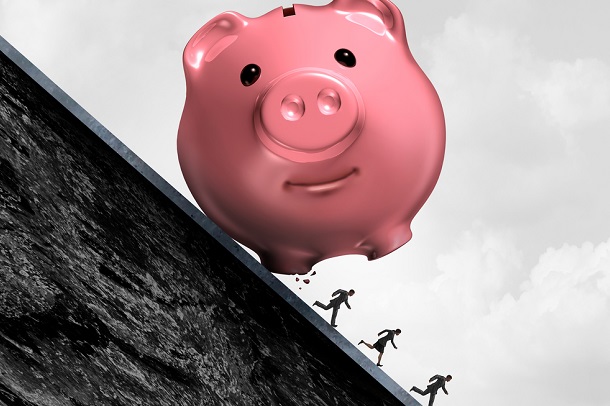 The study illustrates how anxiety is increased by financial worries–just 10 percent of the wealthiest Americans report being very anxious about their future. (Photo: Shutterstock)
The study illustrates how anxiety is increased by financial worries–just 10 percent of the wealthiest Americans report being very anxious about their future. (Photo: Shutterstock)The social bargain that many Americans have accepted (if not embraced)—that extremes of wealth and poverty are part of an equation that allows the middle class to live in comfort and with "enough"—could be breaking down, according to the findings of a new national survey.
"Life Experiences and Income Inequality in the United States," a report from National Public Radio, the Harvard T. Chan School of Public Health Chan, the Robert Wood Johnson Foundation, surveyed more than 1,800 Americans of different levels of household wealth. The findings suggest stark differences in attitudes between the wealthiest and other groups—and a growing sense of insecurity among middle class households. The study looked at several areas of inequality—this article will look at general findings, while part two will focus on health care issues.
Related: Geographic inequality pushing low-skill workers out of cities
"These findings illustrate that adults in the top 1 percent highest income bracket have dramatically different life experiences than those with middle- and lower-incomes," the study said. "Much has been written about low-income adults in the U.S., and these findings reinforce that adults with lower-incomes face significant financial hardships… [but] these findings also raise important concerns about the American middle class."
Different experiences with bills and debt
Not surprisingly, the wealthy are less concerned with unexpected bills—of the top 1 percent of earners ($500,000+ in income), only 4 percent say they would have trouble paying off an unexpected bill of $1,000. Twelve percent of high earners ($100,000 to $499,000) reported that such an expense would be a problem. Just over a third, 34 percent, of middle-income Americans ($35,000 to $99,000) said such an expense would be a problem, and 67 percent of those earning less than $35,000 said a $1,000 expense would be a problem.
For most respondents, the biggest financial challenges were with health care bills, but other areas also were problematic: middle class households report struggling with education bills 30 percent of the time. Education costs were a problem for 33 percent for low-income families, 23 percent for high-income earners, and 12 percent of top-1-percenters.
Trouble paying credit card bills were not that different for low-income households and middle-income earners, at 33 percent and 31 percent, respectively. Higher-income adults reported trouble with these bills 21 percent of the time, highest earners reported trouble with credit card bills 6 percent of the time.
Lower-income Americans also struggle with more basic needs: 35 percent said they have trouble finding an affordable place to live; 30 percent reported having trouble paying for food.
Anxiety and the American Dream
The study illustrates how anxiety is increased by financial worries. Just 10 percent of the wealthiest Americans report being very anxious about their future. For higher-income respondents, the number was 14 percent. For middle-income Americans, 19 percent said they are very anxious about the future; among lower-income Americans, that number is 29 percent.
Even with the current amount of income inequality, many Americans said they believe the American Dream is still in reach. But again, much depends on where the respondents are starting out.
When asked about achieving the American Dream, nearly three-quarters of the highest-income adults, 73 percent, said they have achieved the American Dream, with 24 percent saying they are on their way to achieving it. More than half of high-income adults (54 percent) said they have achieved the American dream, with 39 percent saying they are on their way.
Among middle class respondents, 37 percent said they have achieved the American Dream, 45 percent said they are on their way to achieving it, and 15 percent said they viewed it as out of reach. Among lower-income adults, 20 percent said they have achieved the American Dream, 36 percent said they are on their way to achieving it, and 40 percent say it is out of reach for them.
And despite the financial pressures facing many Americans, a big government solution is not their first choice: less than 50 percent of any income group said income inequality should be a top priority for the next President and Congress.
However, the survey also found a majority of Americans support higher taxes on the wealthy. Nearly half of the top 1-percent earners, 48 percent, supported higher taxes on very wealthy Americans. High-income earners supported higher taxes on the very wealthy at 53 percent, and middle-income and lower-income adults, 55 percent and 61 percent, respectively, said very wealthy Americans should pay more in taxes than they do now.
Read more:
- Optimism falling among middle class, women as fears of recession rise
- Aging exacerbates economic inequality
- Fed's Brainard says middle-class squeeze poses risks to economy
© 2025 ALM Global, LLC, All Rights Reserved. Request academic re-use from www.copyright.com. All other uses, submit a request to asset-and-logo-licensing@alm.com. For more information visit Asset & Logo Licensing.







